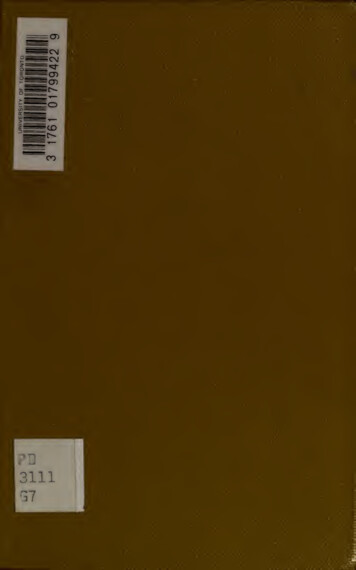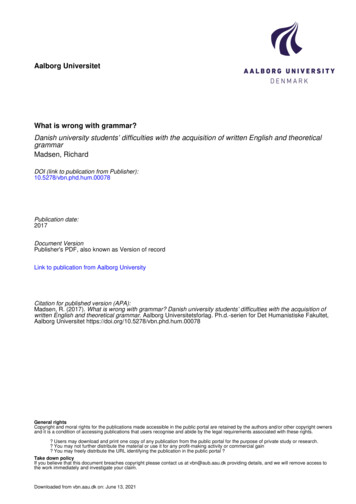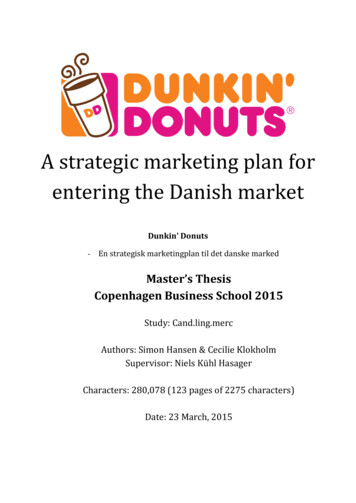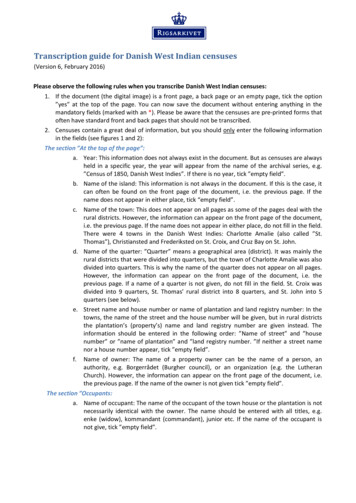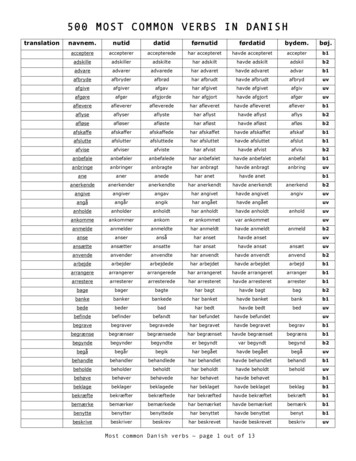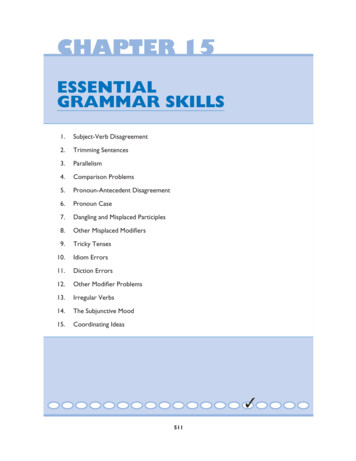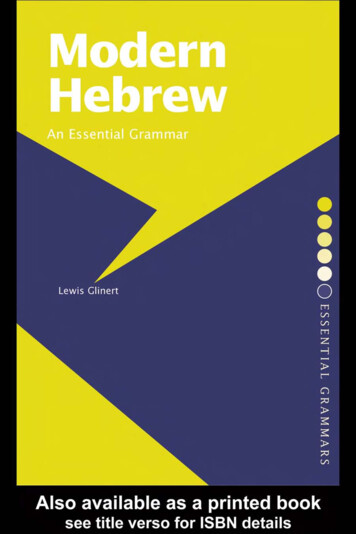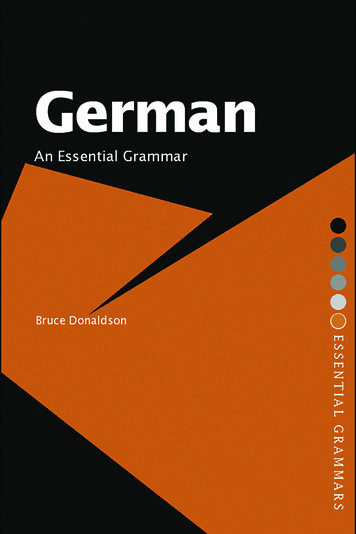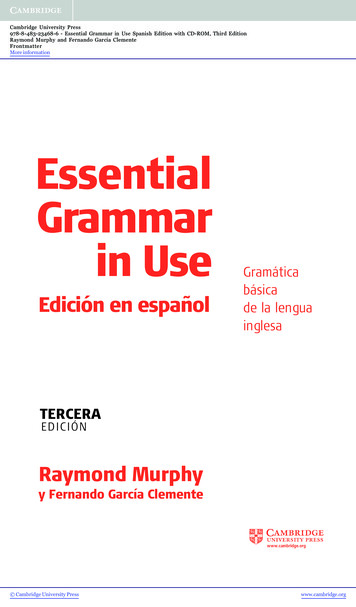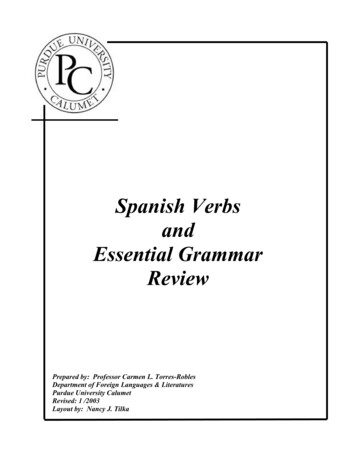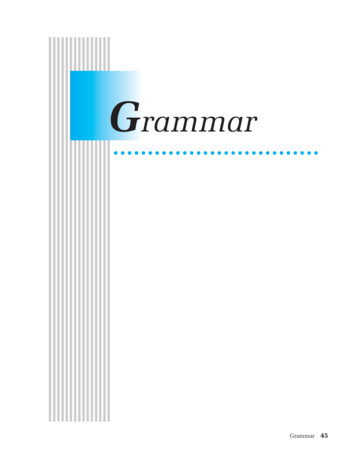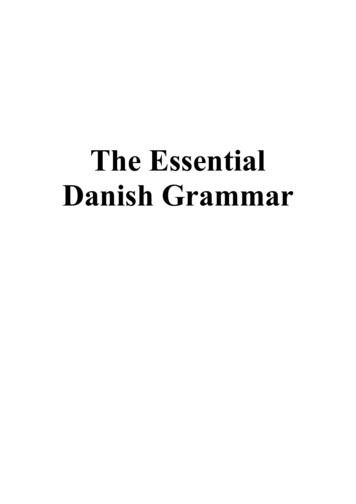
Transcription
The EssentialDanish Grammar
ILanguage historyIINouns1.GenderLike Swedish and Norweigan, Danish is a Scandinavianlanguage that belongs to the German branch of the Indo-European family of languages. Danish is also related to Germanand English.As to vocabulary Danish is closely related to German. Whereinflection is concerned Danish has undergone a developmentwhich means that modern Danish, as opposed to modern German, has a rather reduced inflection system. This is a development that Danish shares with English.The Danish nouns are subdivided into classes according totheir "grammatical gender" (Genus).A division that originally was conditioned by the meaning ofthe noun.The term "gender", meaning grammatical gender, is not to beconfused with biological gender, meaning male and female,but is simply to do with classification of objects or names ofobjects (nouns).English does not have this kind of classification.It is generally supposed that the original indo-europeanmother language contained three genders, masculine, feminine and neuter.In Danish the masculine and feminine are fused into one gender which is called common gender. So modern Danish hastwo genders, common gender and neuter.Common Gender Neuter(N-words) (T-words) en mand a man et hus a house4
Gender is indicated by articles. In the example above by theindefinite articles "en" and "et".Furthermore the gender has consequences for pronouns andfor adjective inflection.In common speech common gender nouns with the article "en"are often called N-words. In common speech neuter nounswith the article "et" are often called T-words.2.Singular and pluralThe Danish nouns have singular and plural forms. Plural endings on Danish nouns are:1) "-(e)r"2) "-e"3) (One group of nouns have the same singularand plural forms).Singularen kvinde a womanen hunda doget fåra sheep3.Pluralmange kvinde-rmange hund-emange fårmany womenmany dogsmany sheepIndefinite and definiteThe Danish nouns have indefinite and definite forms.The indefinite article of common gender nouns is "en" (a/an).For neuter nouns it is "et" (a/an).In the plural the indefinite pronoun "nogle" ("some") is usedas the indefinite article for both grammatical genders (whenthe noun is referring to specific objects).Indefinite IndefiniteCommon gend. NeuterSingular en kvinde a woman et hus a housePlural nogle kvinder some women nogle huse some houses5
DefiniteThe definite article in Danish is enclitic (an ending/a suffixplaced on the noun).Nouns that belong to the common gender class use the definite article "-(e)n".Nouns that belong to the neuter gender class use the definitearticle "-(e)t".In the plural the ending is "-(e)ne" for both genders.NB The definite plural ending is added to the plural formof the noun, not to the singular form.Definite DefiniteCommon gender NeuterSingular kvinde-n the womanhus-etthe housePlural kvinder-ne the womenhuse-ne the housesWhen the noun is qualified by an adjective the definite articleis not an ending. Instead the article ("den", "det" and "de")is placed before the adjective. Historically "den", "det" and"de" are a weakened version of the demonstrative pronoun. den smukke kvinde the beautiful woman det smukke hus the beautiful house de smukke kvinder the beautiful women de smukke huse the beautiful houses"Den" is used before nouns of the common gender class.(N-words)"Det" is used before nouns of the neuter gender class.(T-words)"De" is used in the plural whatever the gender is.No articleDanish nouns in the singular and plural can also appearwithout an article, some with indefinite or unspecific mean6
ing and some with a general meaning (when you generaliseabout things) f.ex: Han har hund He has a dog (dogs) Han sælger biler He sells cars Han elsker kvinder He loves women ( all women)A danish sentence can only begin with an indefinite noun ifthis is generic (applies to a whole group). For example En løve er et farligt dyrA lion is a dangerous animalThis statement refers in principle to all lions, ie the wholespecies.In other situations you must use "der " constructions. Der kommer en bil There is a car comingAND NOT En bil kommer 4.Der er en mand der slår sin hundAND NOT En mand slår sin hundThere is a man who is beating his dogCaseApart from the genitive, Danish nouns do not inflect forcase. The genitive marker is the ending "-s".Singular, definite Singular, definite, Genitive kvinden the woman kvinden-sthe woman’s huset the house huset-s of the house Plural, definitekvinderne the womenhusene the housesPlural, definite, Genitivekvinderne -s the women’shusene -s of the houses7
IIPronouns1.Personal pronounsThe Danish personal pronouns have both subject and ct1. p jeg I mig me vi we os us2. p du you dig you I you jer you3. p han he ham him de they dem themhun she hende her " "den it den it " "det it det it " "The pronouns in the third person singular are divided intocategories "human" and "non human":HumanSubjekthanhunObjektham (referring to male humans)hende (referring to female humans)Non humanden (referring to common gender nouns)det (referring to neuter nouns)The "human" category is subdivided into the two biologicalgenders male and female.The "non human" category is subdivided into two grammatical genders, "common gender" and "neuter".The "non human" category typically includes names ofthings, places and animals.8
2.Reflexive pronounsDanish has reflexive verbs, for example "at vaske sig"("towash oneself")."Sig" is the reflexive pronoun in the third person singular. Han vasker sig He washes (himself) Hun vasker sig She washes (herself) De vasker sig They wash (themselves)Apart from the third person the object pronoun is used asreflexive pronoun, fx: Jeg vasker mig I wash (myself) Du vasker dig You wash (yourself)3.Possessive pronounsThe Danish possessive adjectives in the first and secondperson singular agree with the noun according to grammatical gender and number, for example: min bil my car mit hus my house mine biler my cars mine huse my housesNB These examples are referring to the first person singular, the possessor being "I".The three forms "min", "mit" and "mine" do not (in grammatical terms) agree with the possessor (First person singular "jeg", meaning "I"), but with the possession, which, inthe above examples are common gender – "en bil" (a car)– neuter – "et hus"(a house) and the plural of both - "biler"and "huse".9
Singular (Possessor)Com. gend. possession Neuter possession Plural possession1. P min my/mine2. P din your(s)3. P hans hishendes herdens itsdets its1. P2. P3. P4.mit my/minedit your(s)mine my/minedine your(s)(possessor: human, male)(possessor: human, female)(possessor: non human,referring to common gender noun)(possessor: non human, referring toneuter noun)Plural (Possessor)vores our(s)jeres your(s)deres their(s)Possessive reflexive adjectiveIn the third person singular Danish has a possessive reflexive adjective "sin", "sit", "sine", inflected like "min", "mit","mine". Hun elsker sin mand She loves her husband (her own) Han elsker sin kone He loves his wife (his own) Han elsker hans kone He loves his wife (another man’s)10
III Adjectives1.Declination in number and genderMost Danish adjectives have three forms.Danish adjectives inflect in accordance with grammaticalgender and number, but not in accordance with case.Basic form T-form E-form(Common gender) (Neuter) (Plural) stor big stor-t big stor-e bigThe Danish adjectives agree in gender and number with thenoun they describe (qualify).Gender inflection applies only to the singular.In the plural it does not differentiate between "N"-words(Common gender) and "T"-words (Neuter).Attributive use en stor bila big car et stort husa big house store bilerbig cars store husebig houses2.Predicative usebilen er storthe car is bighuset er stortthe house is bigbilerne er storethe cars are bighusene er storethe houses are bigStrong and week inflectionThe adjectives have two different inflections, strong andweak.The strong inflection ("stor", "stort" and "store") (as demonstrated in the examples shown above) is used in two cases:In predicative use and in attributive use after indefinitearticles, and when you have no articles at all.11
The weak inflection ("store") of the adjective occurs afterthe definite markers like the definite article ("den", "det" or"de", used before adjectives), possessive pronouns and genitives.When the adjectives' inflection is weak the E-form is useddespite gender or number.Singular den store bil min store bil Peters store bil det store hus mit store hus Peters store hus 3.Pluralde store bilermine store bilerPeters store bilerde store husemine store husePeters store husethe big carmy big carPeter's big carthe big housemy big housePeter's big housethe big carsmy big carsPeter's big carsthe big housesmy big housesPeter's big housesComparisonDanish adjectives can be inflected in three degrees.The comparative is made by adding "-(e)re" to the basicform.The superlative is made by adding "-(e)st" to the basic form.Positive høj tallComparative høj-ere tallerSuperlative høj-est tallest12
With certain adjectives, especially long ones, comparativeor superlative forms are made with the help of the adverbs"mere" (more) and "mest" (most).Positive intelligent intelligentComparative mere intelligent more intelligentSuperlative mest intelligent most intelligentIVVerbs1.InfinitiveIn Danish the infinitive form of the verb is constructed byadding "-e" to the verbs stem (the shortest form of the verb).The infinite form is used when a verb has noun characteristics, for example when it takes the grammatical role ofsubject. At rejse er dejligt To travel is lovelyInfinitives are used both in connection with modal verbs anda number of other verbs.With modal verbs "at" disappears from before the infinitive. Jeg skal rejse (modal verb: "skal") I shall travel Jeg elsker at rejse I love to travelThe infinitive is the form of the verb used as the referenceword in dictionaries.2.ParticiplesParticiples are verbal forms that are typically used as adjectives. In Danish there are two participles, present participleand perfect participle:Present participle: spis-ende eatingPerfect participle: spis-t eaten13
2.Person and number3.TenseDanish verbs do not inflect in accordance with person andnumber. The same verbal form is used in the singular andthe plural and also in the first, second and third persons. Jeg spiser I eat/I am eating Han spiser He eats/He is eating De spiser They eat/They are eatingDanish verbs traditionally inflect in four tenses.Present Past Present perfect Past perfect1) hent-er hent-ede har hent-et havde hent-etfetch(es) fetched has/have fetched had fetched2) spis-er spis-te har spis-t havde spis-teat(s) ate has/have eaten had eaten3) gå-r gik er gået var gåetgo(es) went has/have gone had gonePresentFormThe present form is made by adding "-(e)r" to the stem. jeg spis-er I eat/I am eating jeg gå-r I walk/I am walkingUsageThe present form is used for actions and events that takeplace at the time of speaking. Drengen spiser (lige nu) The boy is eating (right now)Danish does not have a progressive verb form as in English "is eating". The actions' continuing duration (durativeaspect) throughout the speaking time is emphasized by theuse of position verbs.14
Drengen sidder og spiserThe boy is eating (litt.: sits and eats) Drengen ligger og soverThe boy is sleeping (litt.: lies and sleeps)The present form can also be used with actions that repeatthemselves or are habitual. (habitual aspect) Drengen spiser altid klokken 12The boy always eats at 12 o’clock Solen går ned om aftenenThe sun sets in the eveningPast (Preterite)FormThe Danish past form is made in three ways.– Group 1 with the ending"-ede"– Group 2 with the ending "-te"– Group 3 Irregular inflection (a smaller groupof frequently used verbs).UsageThe past form is used typically in relation to finished actionsthat take place at definite times or during definite time periods in the past. Drengen spiste klokken 12The boy ate at 12 o’clock Han arbejdede i Tyskland under krigenHe worked in Germany during the warThe actions continuing duration throughout the time ofspeaking can be emphasized by using the past form in combination with verbs of position. Drengen sad og spisteThe boy was eating (litt.: sat and ate)15
Drengen lå og sovThe boy was sleeping (litt.: lay and slept)Special usageThe past tense can be used with present situations when oneis expressing counter-factual meaning, i.e. situations that arenot real but only wished or imagined. Bare jeg var konge (nu) If only I were King (now)The past form can also be used when expressing feelings: Det var en overraskelse! What a suprise!PerfectFormThe present perfect form consists of an auxilliary verb "har"or "er" (has/have or is/am/are) and the perfect participlewith the ending "-(e)t". Han har spis-t He has eaten Han er komm-et He has comeAll verbs that have an object (transitive verbs), use forms ofthe auxilliary verb "at have" (to have).Some verbs that do not have an object (intransitive verbs),for example some verbs of movement, use forms of the auxilliary verb "at være" (to be).UsageThe perfect form has two central areas of use.1) About actions that take place at indefinite times in thepast but still have consequences for the present . Han har rejst meget i udlandetHe has travelled a lot abroad.The time of the persons journey is not defined but the action16
or activity has consequences for the present.The sentence can therefore be interpreted in the followingway: He has (now) much experience with f
Danish Grammar . 4 I Language history Like Swedish and Norweigan, Danish is a Scandinavian language that belongs to the German branch of the Indo-Eu-ropean family of languages. Danish is also related to German and English. As to vocabulary Danish is closely related to German. Where inflection is concerned Danish has undergone a development which means that modern Danish, as opposed to File Size: 303KBPage Count: 22Explore furtherGrammar introduction - Danish - Speakdanishwww.speakdanish.dkPDF Download Danish An Essential Grammar Freewww.nwcbooks.comDanish Grammar - 17 Lessonsilovelanguages.orgRecommended to you based on what's popular Feedback
